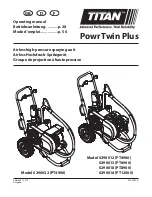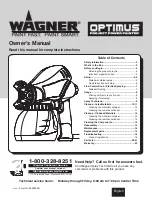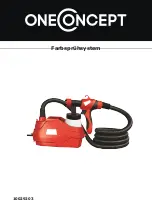
2
PowrTwin Plus
GB
Safety precautions
1.
Safety regulations for Airless spraying
1.1
Explanation of symbols used
This manual contains information that must be read and understood
before using the equipment. When you come to an area that has one
of the following symbols, pay particular attention and make certain
to heed the safeguard.
This symbol indicates a potential hazard that
may cause serious injury or loss of life. Important
safety information will follow.
Attention
This symbol indicates a potential hazard to you
or to the equipment. Important information that
tells how to prevent damage to the equipment or
how to avoid causes of minor injuries will follow.
Danger of skin injection
Danger of fire from solvent and paint fumes
Danger of explosion from solvent, paint fumes
and incompatible materials
Danger of injury from inhalation of harmful
vapors
i
Notes give important information which should
be given special attention.
HAZARD: INjECTION INjuRy
A high pressure stream produced by this equipment
can pierce the skin and underlying tissues, leading to
serious injury and possible amputation.
Do not treat a spraying injury as a harmless cut. In
case of injury to the skin through coating materials
or solvents, consult a doctor immediately for quick
and expert treatment. Inform the doctor about the
coating material or solvent used.
PREVENTION:
• NEVER aim the gun at any part of the body.
• NEVER allow any part of the body to touch the fluid stream.
DO NOT allow body to touch a leak in the fluid hose.
• NEVER put your hand in front of the gun. Gloves will not
provide protection against an injection injury.
• ALWAYS lock the gun trigger, shut the fluid pump off and
release all pressure before servicing, cleaning the tip guard,
changing tips, or leaving unattended. Pressure will not be
released by turning off the engine. The PRIME/SPRAY valve
or pressure bleed valve must be turned to their appropriate
positions to relieve system pressure.
• ALWAYS keep tip guard in place while spraying. The tip guard
provides some protection but is mainly a warning device.
• ALWAYS remove the spray tip before flushing or cleaning the
system.
• NEVER use a spray gun without a working trigger lock and
trigger guard in place.
• All accessories must be rated at or above the maximum
operating pressure range of the sprayer. This includes spray
tips, guns, extensions, and hose.
HAZARD: HIGH PRESSuRE HOSE
The paint hose can develop leaks from wear, kinking
and abuse. A leak can inject material into the skin.
Inspect the hose before each use.
PREVENTION:
• Avoid sharp bending or kinking of the high-pressure hose. The
smallest bending radius amounts to about 20 cm.
• Do not drive over the high-pressure hose. Protect against
sharp objects and edges.
• Replace any damaged high-pressure hose immediately.
• Never repair defective high-pressure hoses yourself!
• Electrostatic charging of spray guns and the high-pressure
hose is discharged through the high-pressure hose. For this
reason the electric resistance between the connections of the
high-pressure hose must be equal to or lower than 1MΩ.
• For reasons of function, safety and durability use only original
Titan high-pressure hoses.
• Before each use, check all hoses for cuts, leaks, abrasion
or bulging of cover. Check for damage or movement of
couplings. Immediately replace the hose if any of these
conditions exist. Never repair a paint hose. Replace it with
another earthed high-pressure hose.
• Make sure power cord, air hose and spray hoses are routed in
such a manner to minimize slip, trip and fall hazard.
HAZARD: EXPLOSION OR FIRE
Solvent and paint fumes can explode or ignite.
Severe injury and/or property damage can occur.
PREVENTION:
• Do not use materials with a flashpoint below 38° C (100° F).
Flashpoint is the temperature at which a fluid can produce
enough vapors to ignite.
• Do not use the unit in work places which are covered by the
explosion protection regulations.
• Provide extensive exhaust and fresh air introduction to
keep the air within the spray area free from accumulation of
flammable vapors.
• Avoid all ignition sources such as static electricity sparks,
electrical appliances, flames, pilot lights, hot objects, and
sparks from connecting and disconnecting power cords or
working light switches.
• Do not smoke in spray area.
• Place sprayer sufficient distance from the spray object in a
well ventilated area (add more hose if necessary). Flammable
vapors are often heavier than air. Floor area must be
extremely well ventilated. The pump contains arcing parts
that emit sparks and can ignite vapors.
• The equipment and objects in and around the spray area must
be properly grounded to prevent static sparks.
• Use only conductive or earthed high pressure fluid hose. Gun
must be earthed through hose connections.
• Power cord must be connected to a grounded circuit (electric
units only).
• Always flush unit into separate metal container, at low pump
pressure, with spray tip removed. Hold gun firmly against side
of container to ground container and prevent static sparks.





































